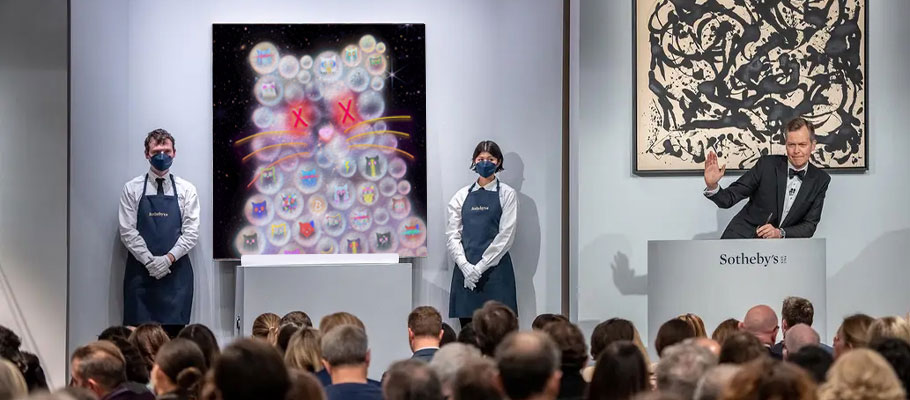
Published: January 24th, 2024
A Bitcoin Ordinals inscription was auctioned off last week for more than USD 250,000 by storied auction house Sotheby’s, the company announced on Monday.
Called Genesis Cat, the Bitcoin artwork by digital creator FAR took in more than 50 bids, with a high bid of 6.31 BTC, equal to roughly USD 253,000.
The ordinal, similar to the non-fungible tokens (NFTs) created for the Ethereum blockchain, is part of the Quantum Cats collection launched by digital studio Taproot Wizards. The project encompasses 3,333 images, which can be inscribed (generated) on Bitcoin’s blockchain for a fee of ca. USD 66,000. The wider collection is set for general release to the public on 29th January.
Taproot Wizards co-founder Udi Wertheimer said in a press release that the Quantum Cats name is an homage to an early form of Bitcoin code called OP_CAT. ‘It was used by Satoshi in the first Bitcoin release but discontinued later,’ he said.
There was fulsome praise from Sotheby's head of digital and contemporary art, Michel Brouhaha. ‘Huge congratulations to everyone who took part in today’s auction,’ he tweeted. ‘And kudos to FAR, who’s curation talents helped bring the sale together.’
According to Sotheby’s, more than 26 BTC (or circa USD 1,096,000 worth) was generated by the wider Ordinals auction taking place that day, with 640 bids and every auction lot sold off. Half the items up for grabs went for more than their upper price estimates.
While this was Sotheby’s first Ordinals-focused event, the famed auction house has handled numerous auctions of Ethereum NFTs. It ran the auction for ‘The Goose’ Art Blocks NFT, selling it for USD 6.1 million in June 2023. The NFT was previously owned by now-bankrupt Three Arrows Capital.
In October 2023, a CrypToadz NFT sold for the eye-watering sum of USD 1.6 million, raising concerns about a possible NFT market bubble. The NFT was purchased on OpenSea for 1,055 in Wrapped Ethereum (WETH). The buyer also paid a fee of nearly USD 42,000 in ETH in addition to the base price.
Big ticket NFT sales on Ethereum were standard fare during 2021's market mayhem, but in 2022 market conditions, where demand for NFT assets had softened considerably, the CrypToadz sale was a standout. Some crypto watchers rang the alarm bells, however, thanks to the transaction’s apparent connection to Tornado Cash.
The fee paid was significantly more than the standard rate for a CrypToadz NFT. They weren’t cheap, but on OpenSea they were selling. For ca. 0.53 ETH or USD 835. The highest listed offer for the seven-figure NFT was slightly higher at 0.6 ETH or USD 940.
Crypto Twitter waded into the controversy by suggesting a ‘fat finger’ error could be to blame, e.g. that the buyer clicked ‘yes’ too many times and paid far more than they meant to. Journalists dug further into the story and found another possible answer: wash trading.
A report in Bloomberg said the wallet that purchased the NFT had been funded recently with 1,115 ETH (worth around USD 1.7 million) from a second wallet. That second wallet had been funded with 1,200 ETH (plus or minus USD 1.9 million) in September from Tornado Cash, the Ethereum coin mixing service.
Tornado Cash allows users to mask the flow of cryptocurrency in and out of wallets by blending funds from different users into a single pool. Doing so obscures the transparency of cryptocurrency flow between wallets, making it harder to track where and amount ETH has come from or where it finally lands.
In February 2023, NFT’s looked to be back in vogue after a rapid rise in Ethereum NFT volumes. Trades more than doubled in an evolving environment that saw challenger NFT marketplace Blur race past OpenSea, the former market leader.
Data from DappRadar showed that traders were rapidly flipping valuable NFTs. Blur was the main beneficiary, logging USD 460 million in Ethereum NFT trades in the same period for 360 per cent jolt over the previous week. OpenSea posted a 12 per cent rise in trading volume to USD 105 million . Runner-up marketplace X2Y2 came in third with ca. USD 11 million in trades.
DappRadar said there had been a week-over-week rise in Ethereum NFT trading volume of more than 150 per cent. The surge began in the same week that Blur airdropped its BLUR governance token, enabling NFT traders to earn rewards in Blur’s marketplace.
At its February price of USD 1.20 per token, BLUR’s performance suggested that some NFT collectors had taken their airdropped funds and poured them back into NFTs. Perhaps incentivized by the airdrop, they also seem to have rewarded Blur by using its marketplace to buy and sell most of their NFTs.
It’s worth noting however that the surge at Blur wasn’t being primarily driven by traders simply flipping their BLUR tokens for high-value NFTs. That activity was driven by NFT ‘whales’ with major NFT holdings. They appeared to be flipping NFTs at even greater frequency than before, likely to improve their position when future token reward allocations are on the cards.
While all of the high profile NFT collections saw sharp declines in 2022, one or two premium collections were still able to benefit. After two multi-million-dollar sales in July of 2022, CryptoPunks saw its floor (minimum) price rise substantially over a period of seven days.
In late July 2022, CryptoPunks saw its floor price on secondary marketplaces leap to USD 100,000. Analyst data at the time showed the floor price reaching as high as USD 113,000.
That meant the entry-level price for CryptoPunks leapt by more than 30 per cent in a week.
Rising Ethereum prices helped drive up NFT prices, though CryptoPunks floor did exceed ETH’s rise by nearly 12 per cent.